The global lactate monitoring devices market is projected to grow from USD 164.4 million in 2025 to approximately USD 390.9 million by 2035, recording an absolute increase of USD 226.5 million over the forecast period. This translates into a total growth of 137.9%, with the market forecast to expand at a CAGR of 9.1% between 2025 and 2035. The market size is expected to grow by nearly 2.38X during the same period, supported by increasing adoption of lactate testing in sports performance monitoring, rising awareness about metabolic health assessment, and growing demand for point-of-care diagnostic solutions.
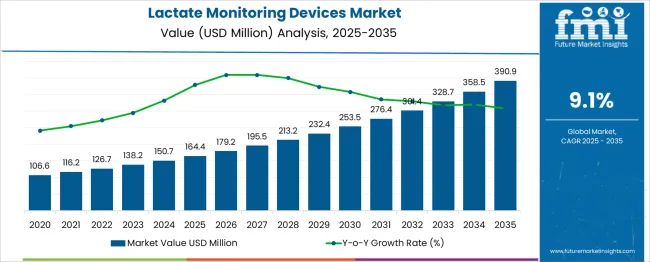
Between 2025 and 2030, the lactate monitoring devices market is projected to expand from USD 164.4 million to USD 253.4 million, resulting in a value increase of USD 89.11 million, which represents 39.3% of the total forecast growth for the decade. This phase of growth will be shaped by rising adoption of lactate monitoring in sports medicine, increasing awareness about exercise physiology, and growing penetration of portable diagnostic devices in fitness centers and sports institutes. Healthcare technology companies are expanding their lactate monitoring product portfolios to address the growing demand for real-time metabolic assessment solutions.
| Metric | Value |
|---|---|
| Estimated Value in (2025E) | USD 164.4 million |
| Forecast Value in (2035F) | USD 390.9 million |
| Forecast CAGR (2025 to 2035) | 9.1% |
From 2030 to 2035, the market is forecast to grow from USD 253.4 million to USD 390.9 million, adding another USD 137.4 million, which constitutes 60.7% of the ten-year expansion. This period is expected to be characterized by expansion of telemedicine and remote monitoring capabilities, integration of advanced biosensor technologies in devices, and development of AI-powered lactate analysis solutions. The growing adoption of personalized medicine and precision fitness monitoring will drive demand for sophisticated lactate monitoring devices with enhanced accuracy and connectivity features.
Between 2020 and 2025, the lactate monitoring devices market experienced steady expansion, driven by increasing focus on sports performance optimization and growing awareness of lactate threshold training. The market developed as sports medicine professionals and fitness enthusiasts recognized the importance of lactate monitoring for training effectiveness and metabolic health assessment. Professional sports teams and individual athletes began adopting lactate testing as a standard practice for performance enhancement and injury prevention.
Market expansion is being supported by the increasing awareness about the role of lactate monitoring in sports performance optimization and metabolic health assessment. Modern athletes and fitness enthusiasts are increasingly focused on data-driven training approaches that can optimize performance, prevent overtraining, and enhance recovery protocols. Lactate monitoring provides real-time insights into metabolic stress, anaerobic threshold, and training intensity, making it an essential tool for evidence-based fitness programming.
The growing focus on personalized medicine and precision fitness is driving demand for accurate, portable lactate monitoring solutions that can be used in various settings from professional sports facilities to home environments. The rise of wearable technology and connected health devices is creating opportunities for integrated lactate monitoring systems that can provide comprehensive metabolic profiles. The increasing influence of sports science research and performance coaching methodologies is also contributing to increased adoption of lactate monitoring across different sports disciplines and fitness levels.
The market is segmented by product, application, end use, and region. By product, the market is divided into battery operated lactate meters, chargeable lactate meters, and others. Based on application, the market is categorized into sports, medical, and others. In terms of end use, the market is segmented into sports institutes, hospitals and clinics, home care, and others. Regionally, the market is divided into North America, Europe, East Asia, South Asia & Pacific, Latin America, and Middle East & Africa.
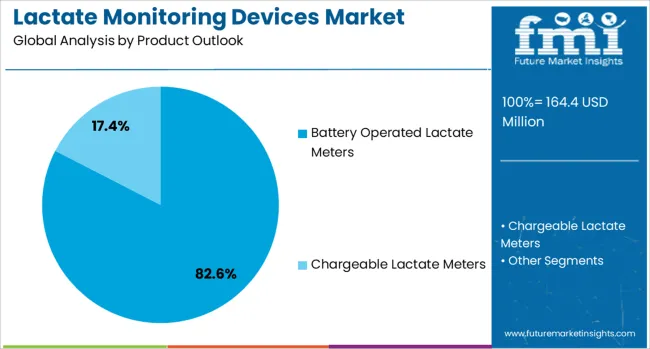
Battery operated lactate meters are projected to account for 82.6% of the lactate monitoring devices market in 2025, establishing their dominance as the preferred portable solution for lactate measurement. These devices offer unparalleled convenience and mobility, allowing users to perform lactate testing in various environments without dependence on power sources. The portability factor is crucial for sports applications where testing needs to occur on training fields, during competitions, or in remote locations.
Battery operated meters provide consistent performance, ease of use, and quick results, making them ideal for both professional and amateur athletes. Their user-friendly design enables immediate lactate assessment during training sessions, allowing for real-time adjustments to exercise intensity. The segment benefits from continuous technological improvements in battery life, measurement accuracy, and device miniaturization. As sports science continues to emphasize the importance of immediate feedback for performance optimization, battery operated lactate meters maintain their position as the gold standard for portable metabolic monitoring.
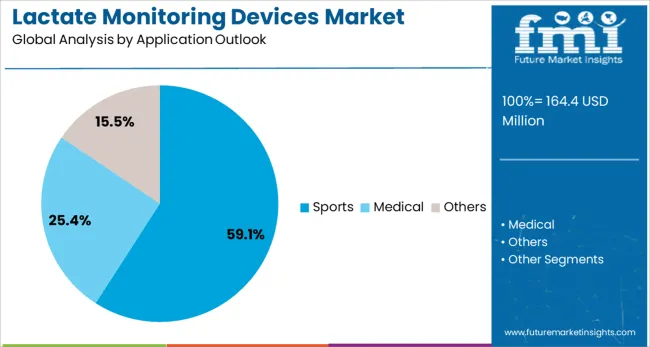
The sports application segment is projected to represent 59.1% of lactate monitoring device demand in 2025, highlighting the critical role of lactate testing in athletic performance optimization. Sports applications encompass training optimization, performance assessment, and recovery monitoring across various disciplines from endurance sports to high-intensity training programs. Athletes and coaches utilize lactate monitoring to determine optimal training zones, assess anaerobic threshold, and prevent overtraining.
The segment is supported by growing awareness of sports science principles and evidence-based training methodologies. Professional sports teams, Olympic training centers, and elite athletes rely on lactate monitoring to gain competitive advantages through precise metabolic assessment. The increasing popularity of endurance sports, cycling, running, and triathlon events drives demand for accurate lactate measurement tools. As sports performance becomes increasingly data-driven and scientific, lactate monitoring serves as a fundamental component of comprehensive athletic assessment and training program development.
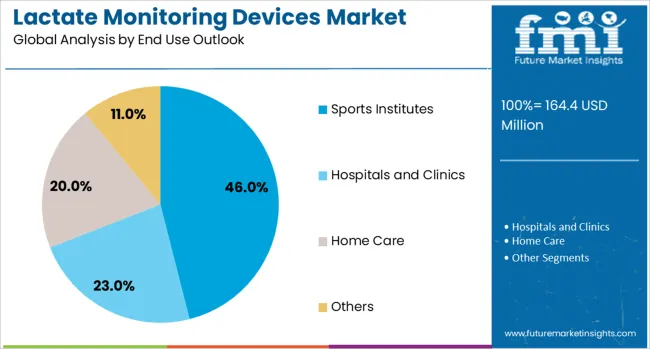
Sports institutes are forecasted to contribute 46% of the lactate monitoring devices market in 2025, reflecting their role as primary adopters of advanced sports science technology. These institutions include professional sports facilities, Olympic training centers, university sports programs, and specialized performance institutes that require sophisticated metabolic monitoring capabilities. Sports institutes utilize lactate monitoring for athlete development, performance research, and training program optimization.
The segment benefits from institutional purchasing power and long-term equipment investment strategies. Sports institutes often serve as testing grounds for new technologies and research platforms for sports science advancement. Their adoption of lactate monitoring devices influences broader market trends and validates the importance of metabolic assessment in athletic development. With increasing focus on scientific training approaches and performance analytics, sports institutes continue to drive innovation and demand for advanced lactate monitoring solutions.
The lactate monitoring devices market is advancing rapidly due to increasing adoption of sports science methodologies and growing awareness about metabolic health monitoring. The market faces challenges including high device costs, technical complexity for some users, and competition from alternative performance monitoring technologies. Innovation in biosensor technology and wireless connectivity continues to influence product development and market expansion patterns.
The increasing acceptance of scientific training approaches among athletes and fitness professionals is driving demand for precise metabolic monitoring tools. Sports science research continuously validates the importance of lactate threshold testing for performance optimization, creating demand for reliable monitoring devices. Educational programs for coaches and trainers are expanding knowledge about lactate physiology and its applications in training program design.
Modern lactate monitoring devices are incorporating wireless connectivity, smartphone integration, and cloud-based data management systems to provide comprehensive performance tracking. These connected solutions enable long-term trend analysis, progress monitoring, and integration with other fitness metrics. Advanced analytics platforms are emerging that combine lactate data with heart rate, power output, and other physiological parameters for holistic performance assessment.
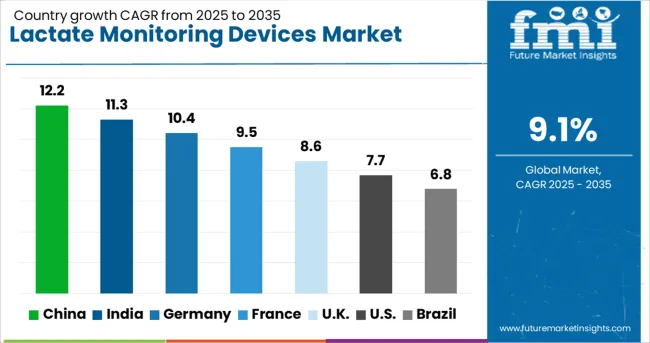
| Countries | CAGR (2025-2035) |
|---|---|
| China | 12.2% |
| India | 11.3% |
| Germany | 10.4% |
| France | 9.5% |
| UK | 8.6% |
| USA | 7.7% |
| Brazil | 6.8% |
The lactate monitoring devices market is experiencing robust growth globally, with China leading at a 12.2% CAGR through 2035, driven by massive sports infrastructure development, Olympic preparation programs, and increasing adoption of sports science technologies. India follows at 11.3%, supported by growing sports culture, increasing health consciousness, and expanding sports medicine facilities. Germany shows strong growth at 10.4%, emphasizing precision engineering and sports science research. France records 9.5%, focusing on professional sports development and endurance training programs. The UK demonstrates 8.6% growth, driven by sports institutes and fitness industry adoption.
Revenue from lactate monitoring devices in China is projected to exhibit exceptional growth with a CAGR of 12.2% through 2035, driven by comprehensive sports development programs and increasing investment in athlete performance optimization. The country's preparation for international competitions and focus on sports excellence create substantial demand for advanced metabolic monitoring equipment. Major sports institutes and professional teams are adopting scientific training methodologies that require precise lactate measurement capabilities.
Revenue from lactate monitoring devices in India is expanding at a CAGR of 11.3%, supported by rising sports participation, increasing awareness of sports science, and growing investment in athlete development programs. The country's success in various international sports is driving adoption of advanced training technologies including lactate monitoring systems. Professional sports leagues and training academies are implementing scientific approaches to performance enhancement.
Demand for lactate monitoring devices in Germany is projected to grow at a CAGR of 10.4%, supported by the country's strong engineering capabilities, focus on precision measurement, and well-established sports science research infrastructure. German manufacturers and research institutions are developing advanced lactate monitoring technologies that set global standards for accuracy and reliability.
Revenue from lactate monitoring devices in France is projected to grow at a CAGR of 9.5% through 2035, driven by the country's strong tradition in endurance sports, cycling, and professional athlete development. French sports institutes and training centers emphasize scientific approaches to performance optimization, creating demand for accurate metabolic monitoring equipment.
Revenue from lactate monitoring devices in the UK is projected to grow at a CAGR of 8.6% through 2035, supported by well-established sports institutes, professional sports leagues, and a focus on evidence-based training methodologies. British sports science research and Olympic programs drive demand for sophisticated metabolic monitoring capabilities.
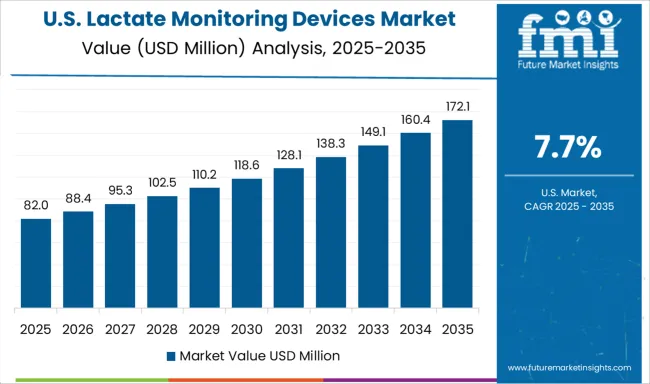
Revenue from lactate monitoring devices in the USA is projected to grow at a CAGR of 7.7% through 2035, supported by extensive sports medicine infrastructure, professional sports leagues, and widespread adoption of performance monitoring technologies. American athletes and sports organizations utilize lactate monitoring for competitive advantage and injury prevention.
Revenue from lactate monitoring devices in Brazil is projected to grow at a CAGR of 6.8%, supported by increasing investment in sports infrastructure, growing football science applications, and expanding fitness culture. The country's focus on sports excellence and international competition preparation drives adoption of advanced training technologies.
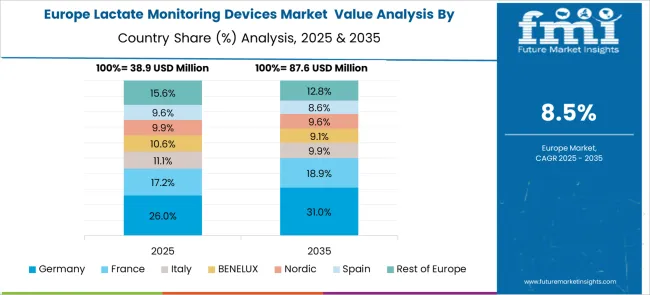
The European lactate monitoring devices market demonstrates sophisticated development across major economies with Germany leading through its precision engineering excellence and advanced sports science capabilities, supported by companies emphasizing high-accuracy measurement systems, innovative biosensor technologies, and comprehensive performance monitoring solutions while maintaining strict quality standards and clinical validation protocols. The UK shows strength in sports institute adoption and evidence-based training methodologies, with organizations specializing in portable lactate analyzers and sports performance optimization systems that meet rigorous scientific standards.
France contributes through its strong endurance sports culture and professional athlete development programs, delivering specialized lactate monitoring solutions that combine traditional sports expertise with modern metabolic assessment science. Sweden and Nordic countries emphasize precision measurement and sports technology development. Italy and Spain demonstrate growth in specialized sports medicine applications and fitness industry adoption. The market benefits from stringent EU medical device regulations, established sports science research infrastructure, and growing demand for accurate, portable lactate monitoring solutions that provide superior performance insights.
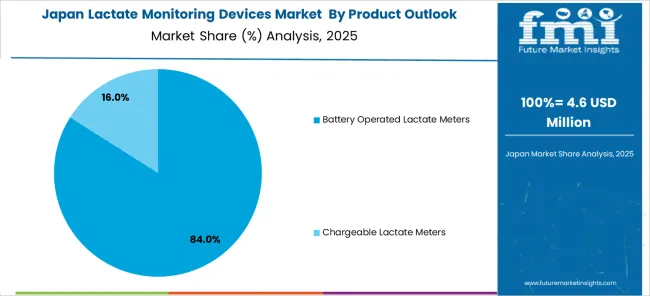
The Japanese lactate monitoring devices market demonstrates steady growth driven by precision manufacturing focus, advanced sensor technology development, and sports science preference for high-quality measurement systems that ensure superior accuracy and reliability throughout athletic performance assessment. Japanese organizations prioritize sophisticated diagnostic capabilities and stringent quality standards, creating demand for lactate monitoring devices featuring advanced biosensor technology, comprehensive data analytics, and integrated performance management systems that align with Japanese precision manufacturing excellence.
The market emphasizes technological innovation in sensor accuracy, device miniaturization, and data connectivity systems that reflect Japanese attention to detail in sports technology development and performance optimization. Growing investment in Olympic preparation programs and sports science research supports adoption of intelligent monitoring systems with real-time measurement capabilities, wireless connectivity, and advanced analytics for enhanced athletic performance assessment. Japanese sports institutes focus on measurement precision, consistent device performance, and long-term reliability for professional athlete development programs.
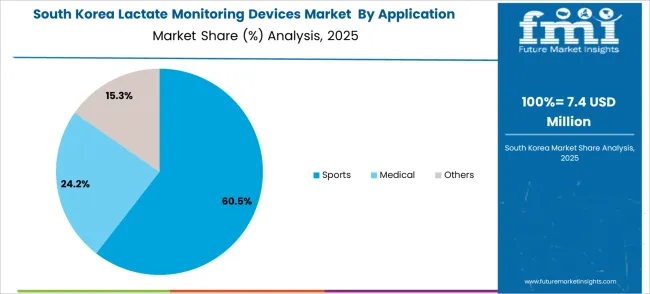
The South Korean lactate monitoring devices market shows exceptional growth potential driven by expanding sports infrastructure development, increasing adoption of scientific training methodologies, and growing demand for advanced performance monitoring equipment requiring precision measurement and comprehensive data management capabilities. The market benefits from South Korea's technological leadership in electronics manufacturing and increasing focus on international sports competitiveness that drives investment in sophisticated sports science equipment meeting global standards.
Korean sports organizations increasingly adopt evidence-based training approaches, metabolic assessment protocols, and integrated performance monitoring systems to improve athletic outcomes and competitive positioning while ensuring scientific accuracy requirements. Growing influence of Korean sports science research and technology companies supports demand for advanced lactate monitoring platforms that ensure measurement reliability while maintaining cost-effectiveness and user accessibility. The integration of connected health technologies and mobile applications creates opportunities for intelligent monitoring systems with real-time data analysis and performance optimization capabilities.
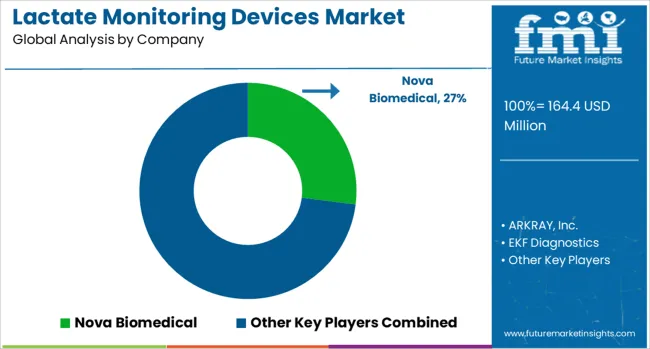
The lactate monitoring devices market is characterized by competition among specialized medical device manufacturers, sports technology companies, and diagnostic equipment providers. Companies are investing in biosensor technology advancement, user interface improvement, connectivity features, and accuracy enhancement to deliver reliable, user-friendly, and comprehensive lactate monitoring solutions. Product innovation, clinical validation, and market penetration strategies are central to strengthening competitive positioning and market presence.
nova biomedical, USA-based, leads the market with 27% global value share, offering clinically-validated lactate monitoring systems with focus on accuracy, reliability, and ease of use. ARKRAY Inc., Japan-based, provides comprehensive diagnostic solutions, including lactate meters, with a focus on precision measurement and user-friendly operation. EKF Diagnostics, UK-based, delivers point-of-care testing solutions with a focus on rapid results and clinical accuracy. TECOM Analytical Systems specializes in sports science applications with portable lactate analyzers designed for field testing.
Sensa Core Medical focuses on innovative biosensor technologies for improved measurement accuracy and reduced testing time. VivaCheck Biotech provides accessible lactate monitoring solutions with a focus on affordability and ease of use. ApexBio offers specialized lactate testing equipment for research and clinical applications. TaiDoc Technology Corporation delivers consumer-oriented devices with a focus on the home and fitness market segments.
| Items | Values |
|---|---|
| Quantitative Units (2025) | USD 164.4 million |
| Product | Battery Operated Lactate Meters, Chargeable Lactate Meters, Others |
| Application | Sports, Medical, Others |
| End Use | Sports Institutes, Hospitals and Clinics, Home Care, Others |
| Regions Covered | North America, Europe, East Asia, South Asia & Pacific, Latin America, Middle East & Africa |
| Countries Covered | United States, Canada, United Kingdom, Germany, France, China, Japan, South Korea, India, Brazil, Australia and 40+ countries |
| Key Companies Profiled | nova biomedical, ARKRAY Inc., EKF Diagnostics, TECOM Analytical Systems, Sensa Core Medical, VivaCheck Biotech, ApexBio, and TaiDoc Technology Corporation |
| Additional Attributes | Dollar sales by device type and technology level, regional demand trends, competitive landscape, buyer preferences for portability versus accuracy, integration with sports performance analytics, innovations in biosensor technology, wireless connectivity, and data management systems |
North America
Europe
East Asia
South Asia & Pacific
Latin America
Middle East & Africa
The global lactate monitoring devices market is estimated to be valued at USD 164.4 million in 2025.
The market size for the lactate monitoring devices market is projected to reach USD 390.9 million by 2035.
The lactate monitoring devices market is expected to grow at a 9.1% CAGR between 2025 and 2035.
The key product types in lactate monitoring devices market are battery operated lactate meters and chargeable lactate meters.
In terms of application outlook, sports segment to command 59.1% share in the lactate monitoring devices market in 2025.






Our Research Products

The "Full Research Suite" delivers actionable market intel, deep dives on markets or technologies, so clients act faster, cut risk, and unlock growth.

The Leaderboard benchmarks and ranks top vendors, classifying them as Established Leaders, Leading Challengers, or Disruptors & Challengers.

Locates where complements amplify value and substitutes erode it, forecasting net impact by horizon

We deliver granular, decision-grade intel: market sizing, 5-year forecasts, pricing, adoption, usage, revenue, and operational KPIs—plus competitor tracking, regulation, and value chains—across 60 countries broadly.

Spot the shifts before they hit your P&L. We track inflection points, adoption curves, pricing moves, and ecosystem plays to show where demand is heading, why it is changing, and what to do next across high-growth markets and disruptive tech

Real-time reads of user behavior. We track shifting priorities, perceptions of today’s and next-gen services, and provider experience, then pace how fast tech moves from trial to adoption, blending buyer, consumer, and channel inputs with social signals (#WhySwitch, #UX).

Partner with our analyst team to build a custom report designed around your business priorities. From analysing market trends to assessing competitors or crafting bespoke datasets, we tailor insights to your needs.
Supplier Intelligence
Discovery & Profiling
Capacity & Footprint
Performance & Risk
Compliance & Governance
Commercial Readiness
Who Supplies Whom
Scorecards & Shortlists
Playbooks & Docs
Category Intelligence
Definition & Scope
Demand & Use Cases
Cost Drivers
Market Structure
Supply Chain Map
Trade & Policy
Operating Norms
Deliverables
Buyer Intelligence
Account Basics
Spend & Scope
Procurement Model
Vendor Requirements
Terms & Policies
Entry Strategy
Pain Points & Triggers
Outputs
Pricing Analysis
Benchmarks
Trends
Should-Cost
Indexation
Landed Cost
Commercial Terms
Deliverables
Brand Analysis
Positioning & Value Prop
Share & Presence
Customer Evidence
Go-to-Market
Digital & Reputation
Compliance & Trust
KPIs & Gaps
Outputs
Full Research Suite comprises of:
Market outlook & trends analysis
Interviews & case studies
Strategic recommendations
Vendor profiles & capabilities analysis
5-year forecasts
8 regions and 60+ country-level data splits
Market segment data splits
12 months of continuous data updates
DELIVERED AS:
PDF EXCEL ONLINE
Pain Monitoring Devices Market Size and Share Forecast Outlook 2025 to 2035
Dose Monitoring Devices Market - Growth & Demand 2025 to 2035
Noise Monitoring Devices Market Size and Share Forecast Outlook 2025 to 2035
Nerve Monitoring Devices Market Insights - Growth & Forecast 2025 to 2035
Patient Monitoring Devices Market Size and Share Forecast Outlook 2025 to 2035
Epilepsy Monitoring Devices Market Growth - Trends & Forecast 2025 to 2035
Compliance Monitoring Devices Market Trends and Forecast 2025 to 2035
Vital Signs Monitoring Devices Market Analysis - Trends & Forecast 2025 to 2035
Blood Glucose Monitoring Devices Market Size and Share Forecast Outlook 2025 to 2035
Remote Patient Monitoring Devices Market Size and Share Forecast Outlook 2025 to 2035
Demand for Glucose Monitoring Devices in EU Size and Share Forecast Outlook 2025 to 2035
Continuous Cardiac Monitoring Devices Market Size and Share Forecast Outlook 2025 to 2035
Pet Blood Pressure Monitoring Devices Market Size and Share Forecast Outlook 2025 to 2035
Frictionless Remote Monitoring Devices Market Size and Share Forecast Outlook 2025 to 2035
Intraoperative Neuromonitoring Devices Market
Cardiac Rhythm Remote Monitoring Devices Market Size and Share Forecast Outlook 2025 to 2035
Cardiac Monitoring And Cardiac Rhythm Management Devices Market Size and Share Forecast Outlook 2025 to 2035
Non-Invasive Blood Glucose Monitoring Devices Market Size and Share Forecast Outlook 2025 to 2035
Monitoring Tool Market Size and Share Forecast Outlook 2025 to 2035
Lactate Market Analysis – Trends & Forecast 2024-2034

Thank you!
You will receive an email from our Business Development Manager. Please be sure to check your SPAM/JUNK folder too.
Chat With
MaRIA